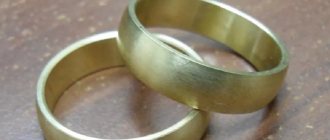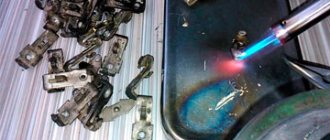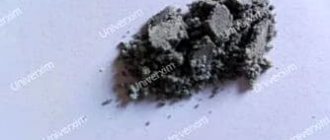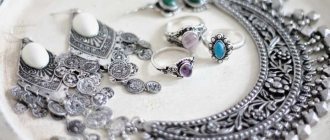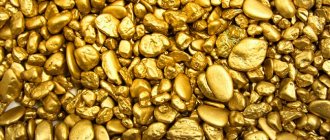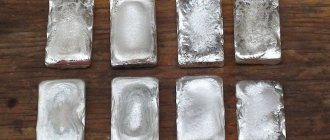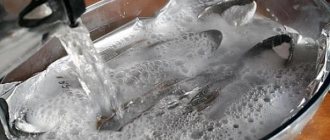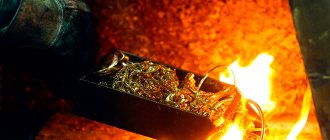The fear of being deceived haunts many people, and this fear is not unfounded. According to statistics, over the past 10 years the production of precious metals has practically not increased, but at the same time the number of jewelry stores is growing at an incredible pace. Alas, even when buying jewelry in a jewelry store, there is a chance of running into a low-quality fake. Are you overcome by doubts? Verifying the authenticity of precious metals is available not only to specialists, but to each of us. There are many ways to do this, which can be done at home.
What is better for health, gold or silver?
In terms of health benefits, silver products are better than gold ones. In what cases should men and women wear them? Silver jewelry looks less provocative than gold. Any massive earrings or bracelets will not seem vulgar if they are made from this material.
Interesting materials:
How much does a Rolls Royce figurine cost? How much does a taxi cost to Domodedovo airport? How much does Theraflu powder cost? How much does it cost to install sockets? How much does it cost to bury an urn in a columbarium? How much does it cost to replace a license through government services? How much does a WWII subscription token cost? How much does a golden chinchilla cost? How many pages are in the book Tom Sawyer? How many pages are there in the Red Book?
Determination of steel grade
Steel blanks are made from solid metal solutions based on carbon and iron. Depending on the carbon content, materials are divided into: low-carbon (up to 0.25%), medium-carbon (up to 0.6%), high-carbon (0.6% or more).
Alloying steels with additional materials makes it possible to achieve a higher quality composition with unique properties. The following can be added: titanium, nickel, copper, molybdenum, etc. There are high-alloy steels (from 10%), medium-alloy steels (up to 10%) and low-alloy steels (up to 2.5%).
Typically, steel blanks have markings that allow you to determine the grade and other characteristics of the material by visual inspection. But if there are no such marks, you can use the following methods to obtain the necessary information:
- Carefully cut off the top thin material. We examine the resulting chips for fragility. If it is impossible to cut off a full curl or it is easy to break, then this means that you have high-carbon steel. A material with a low carbon content will produce dense, long chips with a uniform structure that will be easy to cut.
- If you have a stove, you can use a more energy-intensive method. We make a cut on the workpiece, and then expose it to the highest possible temperature. After hardening, we re-cut. If this required little force, as when cutting cold material, then the steel is low carbon.
- We take a grinding wheel and prepare the workplace - we provide good lighting, and set a dark background behind. Our task is to determine the type of steel by the characteristics of the sparks struck. If they are bright and there are a lot of them, then the material is saturated with carbon. In soft low-carbon steels, sparks are dull and their particles are small.
- Using a grinding wheel, you can also identify the metal by the color of the sparks. So, if the shade of the stars is red, then you are dealing with high-carbon steel. A light sheaf with a small amount of sparks indicates that the sample is medium carbon. If the metal is poorly saturated with carbon, it will form straw-colored rays without stars at the ends.
Image No. 2: determining the steel grade by spark
Iodine test
You can check the authenticity of the metal using an iodine solution purchased at a pharmacy. A drop of iodine is applied to the surface and left for several seconds. Iodine will not harm noble metals - gold, platinum, silver. If the color of a drop of iodine does not change, and after removing it with a napkin, no traces or stains remain, this indicates the authenticity of the metal. If darkening is visible at the place of the drop, then this is a low-quality alloy or an outright fake.
Heat check
You can also determine the group of a metal by how it conducts heat. It is known that the thermal conductivity of silver is very high. It is almost five times higher than that of iron or platinum. Slightly worse for gold, copper and aluminum. Platinum transfers heat even weaker than iron.
If you immerse the metal in hot water for 15–20 seconds, then based on its temperature, determined by touch, you can draw some conclusions.
- Gold and silver objects will become as hot as the water in which they were dipped.
- During this time, platinum and items containing iron will become warm, but not hot.
In this way it is easy to distinguish platinum from silver. But it’s not possible to compare silver or aluminum alloy.
Magnet check
Bringing a magnet close to the item being tested is a good way to perform initial testing. By the reaction of the magnet you can determine which group the metal belongs to:
- Ferromagnets. The magnet is clearly attracted to the object, which means that the product may contain iron, steel or nickel.
- Paramagnetic materials. The interaction with the magnet is very weak. This group includes aluminum and chrome. Precious metals that are paramagnetic are platinum, palladium and silver.
- Diamagnets. In general, they do not react to magnets. Copper and zinc have these properties. Precious metals - gold.
Of course, such a check will not allow us to accurately determine the material from which the item is made. After all, a non-magnetic metal may not be in its pure form, but in the form of an alloy with a ferromagnet. But it can confirm or refute the assumption. For example, if it is checked whether it is gold or not, but the item is clearly magnetic, then it can be argued that it is a fake.
When checking jewelry, you should take into account that, in addition to precious metals, they may contain clasps, built-in springs, made of another material. You need to check the metal itself.
Vinegar test
Household vinegar solution also does not affect precious metals. And it is dangerous for counterfeits. But, unlike the iodine test, acetic acid takes time. To wait for the result, you need to immerse the metal being tested in a container with vinegar for 15–30 minutes. The absence of traces of interaction between metal and vinegar is a sign of nobility.
If, in addition to metal, the product contains precious or semi-precious stones, then it is better not to check them this way; vinegar can ruin them. This is especially true for pearls.
Authentication of platinum jewelry: your own expert
Platinum is a precious metal used in jewelry making. The silver-white metal gained its fame back in the 18th century, but only in our time has it become widely used by jewelers. As a rule, only small jewelry such as rings, earrings and chains are made from platinum. This is due to the high cost of the material.
With the spread of the Internet, purchasing jewelry has become much easier. However, you will not have the opportunity to examine the product before purchasing, which means you may encounter a fake. Many people prefer not to take risks by purchasing jewelry in specialized stores, but even in this case you are not immune from counterfeiting. So how can you independently verify the authenticity of jewelry made from platinum?
Determination of product weight and density
Platinum is a heavy metal, the weight of which is comparable only to iridium, osmium, rhenium and uranium. All other elements are easier. In addition, in the production of jewelry, the specific gravity of platinum ranges from 85% to 95% of the total weight of the product. That is, jewelry is almost 100% made of this noble metal. Products made of gold and silver, for example, contain much less precious metal.
The use of iridium, osmium and rhenium to make jewelry heavier is inappropriate, since these elements have the same cost as platinum, and they are rarely found in nature. Pick up a platinum ring and a similar sized ring made of another metal. A product made of platinum will be heavier than a similar piece of jewelry made from a different alloy.
May 28, 2016 at 8:30 PDT
Real silver darkens over time. But this takes years, and besides, its shine can be easily restored. To do this, use a special cream or ammonia. The shine of low-quality products disappears forever.
Silver test
One of the most accurate methods for determining the authenticity of silver at home is a silver test, which can be purchased in specialized stores or online. By following simple instructions, with a high degree of probability you can determine not only the authenticity of the product, but also the approximate sample.
There are electronic devices that can distinguish silver, gold, white gold, and platinum. However, their cost is so high that purchasing them for the purpose of one-time determination of precious metals at home is not economically justified.
Dental check
From novels and films we know that they used to test the authenticity of gold coins by biting them. What exactly can be installed in this “old-fashioned” way? Gold is a soft metal. Therefore, even with a weak bite, a dent from the teeth remains on it. Fake alloys do not have this property; you cannot take them with your teeth.
Such a test gives good results for high-quality products. The higher the pure gold content, the softer it is. Gold of 900 purity and higher is so soft that they try not to expose valuable items made from it to contact with other objects.
Density check
One of the reliable ways to determine the type of metal or alloy is to determine its density. For pure gold it is two times higher than for copper and almost three times higher than for iron. Platinum is even heavier than gold. Even an alloy of 585 gold is noticeably heavier than base metals.
Of course, to determine the exact density of a small product you will need pharmaceutical scales, volume calculations (Archimedes' law to help) and tabular data on the density of base metals. But to solve the question of what the alloy is mainly made of, gold or another metal, rough estimates are sufficient. If you have at hand an object made of obviously genuine metal of approximately equal volume, then you may not even need a scale. A weight difference of two to three times is not so difficult to catch.
Separately, each of the considered methods will not give an exact answer to the question of what metal the product is made of. But if several different tests show the same results, you can be confident in the correct determination. If not, then you will have to turn to professionals.
Source: dedantikvar.com
How to check?
Owners of platinum jewelry should remember:
- Platinum is an expensive and heavy metal, and small jewelry is often made from it.
- Platinum can be replaced with silver, but such a substitution can be recognized by color.
- The hardest thing to distinguish from the original is jewelry that has a layer of platinum applied to it.
- The mark on the surface of the product should not raise doubts.
- Platinum is not afraid of high temperatures and reagents.
The cost of platinum is constantly increasing; there is not much of this metal in the world. Therefore, if in a store a buyer is offered to purchase an impressively sized product made of platinum, and its cost is quite low, he should refuse the purchase. Platinum is not sold cheaply, and jewelry made from it is small; the metal is too heavy.
Platinum Bank Bar
Silver and platinum are similar in appearance, so the expensive metal is often replaced with silver. Such a fake will give itself away with a black tint and plasticity. Silver is not resistant to damage; a mark will remain on its surface, but it will not be possible to spoil a platinum product in this way.
If a layer of platinum is applied to the surface of the product, then a fake can be recognized by its weight. When this is not possible, it will not be possible to determine its quality without causing damage to the jewelry.
Before purchasing, you need to carefully examine the mark; you can use a magnifying glass for this. If all the numbers are clearly visible, most likely the jewelry is really made of platinum.
Due to its chemical properties, platinum is not afraid of high temperatures and acids. When immersed in acid, ammonia and even when exposed to iodine, the product will not change. If you try to heat a ring or earring with a lighter, the temperature of the jewelry will not change immediately. Platinum is a poor conductor of heat, unlike silver.
How to distinguish stainless steel from aluminum at home?
Cleaned (abrasive) samples can be tested using thick white paper. Run the metal over the paper (with force). Aluminum will leave a gray mark on the paper, but stainless steel will not.
Interesting materials:
Can medical gold be cleaned? Is it possible to give a robe of omens? Can I give vegetable puree the next day? Is it possible to give a pacifier during breastfeeding? Can I give my dog oatmeal? Is it possible to do biochemistry on colored hair? Is it possible to make potato pancakes in a blender? Is it possible to make rolls with iodized salt? Is it possible to keep a Wombat at home? Is it possible to keep turkeys outside in winter?
Application of chemicals
Testing with active chemical reagents should be left as a last resort. If handled improperly, they will damage even genuine precious metal. And they can be dangerous for the health of the inspector.
Pure gold does not react to ammonia. But practically no products intended for use are made from gold 900 and 999, only for collections. And on a precious metal of lesser purity, ammonia can leave an irremovable mark. Its solution in combination with other substances is used to clean gold items. Therefore, it is not worth identifying gold and silver items using ammonia.
